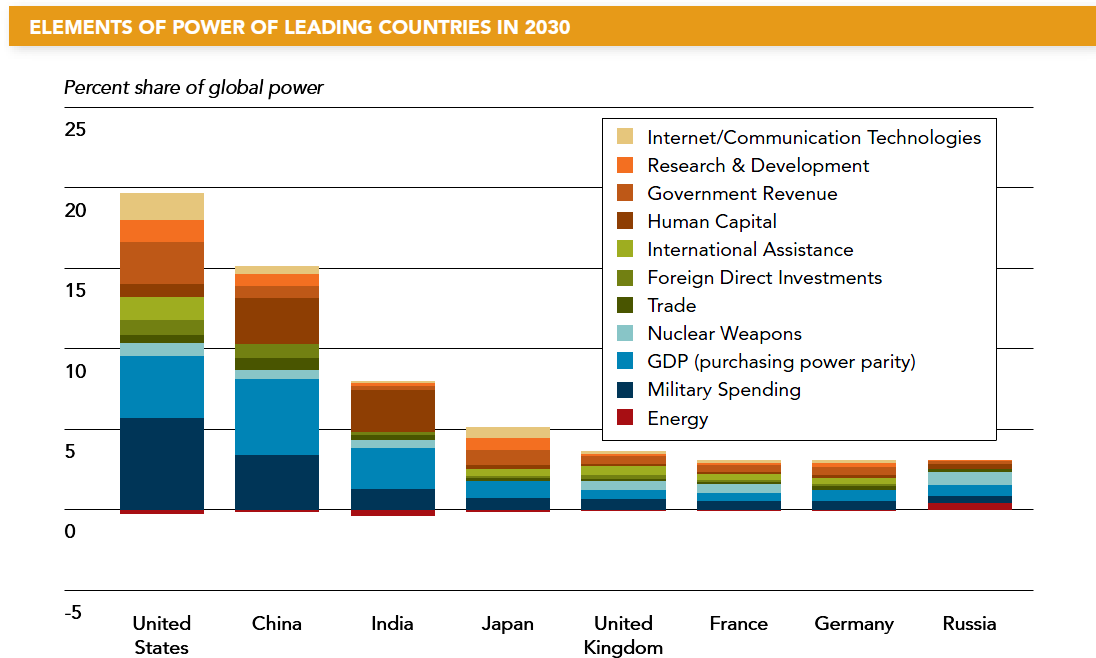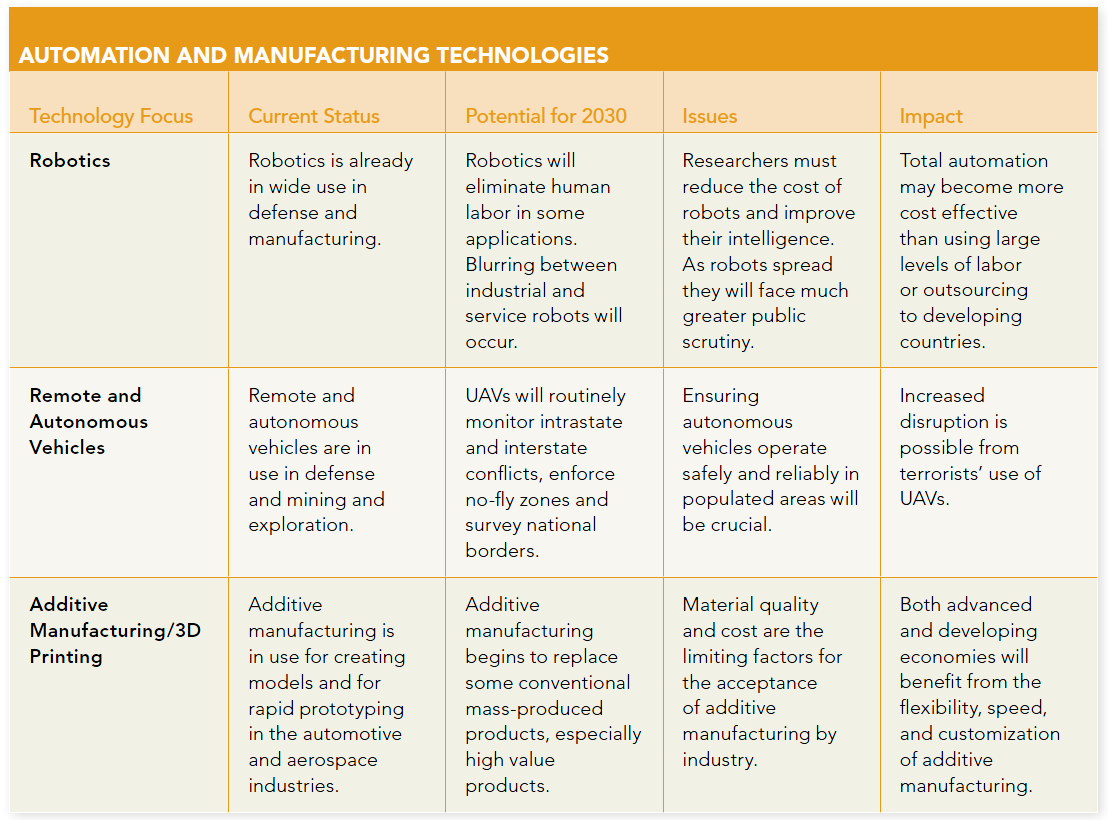Global Trends 2030: Alternative Worlds
December 12, 2012
The National Intelligence Council has issued Global Trends 2030: Alternative Worlds, “intended to stimulate thinking about the rapid and vast geopolitical changes characterizing the world today and possible global trajectories during the next 15-20 years.”
The report sees four megatrends:
Individual empowerment will accelerate substantially during the next 15-20 years owing to poverty reduction and a huge growth of the global middle class, greater educational attainment, better health care, and widespread exploitation of new communications and manufacturing technologies. Enabled by communications technologies, power will shift toward multifaceted and amorphous networks that will form to influence state and global actions.
Diffusion of power among countries will have a dramatic impact by 2030. Asia will have surpassed North America and Europe combined in terms of global power, based upon GDP, population size, military spending, and technological investment. China alone will probably have the largest economy, surpassing that of the United States a few years before 2030.
Demographic Patterns: in the world of 2030—a world in which a growing global population will have reached somewhere close to 8.3 billion people (up from 7.1 billion in 2012)—four key trends will be aging—a shrinking number of youthful societies and states; migration, which will increasingly be a cross-border issue; and growing urbanization, which will spur economic growth but could put new strains on food and water resources.
Growing Food, Water, and Energy Nexus: Demand for food, water, and energy will grow by approximately 35, 40, and 50 percent respectively owing to an increase in the global population and the consumption patterns of an expanding middle class. Climate change will worsen the outlook for the availability of these critical resources.

Source: International Futures Model
Human Augmentation
The report sees human augmentation spanning a wide gamut of technologies, ranging from implants and prosthetics to powered exoskeletons, for enhancing innate human abilities, or replacing missing or defective functions such as damaged limbs. Prosthetic limbs have now reached the stage where they offer equivalent or slightly improved functionality to human limbs. Brain-machine interfaces in the form of brain-implants are demonstrating that directly bridging the gap between brain and machine is possible. Military organizations are experimenting with a wide range of augmentation technologies, including exoskeletons that allow personnel to carry increased loads and psychostimulants that allow personnel to operate for longer periods.
Human augmentation could allow civilian and military people to work more effectively, and in environments that were previously inaccessible. Elderly people may benefit from powered exoskeletons that assist wearers with simple walking and lifting activities, improving the health and quality of life for aging populations. Successful prosthetics probably will be directly integrated with the user’s body. Brain-machine interfaces could provide “superhuman” abilities, enhancing strength and speed, as well as providing functions not previously available.
As replacement limb technology advances, people may choose to enhance their physical selves as they do with cosmetic surgery today. Future retinal eye implants could enable night vision, and neuro-enhancements could provide superior memory recall or speed of thought. Neuro-pharmaceuticals will allow people to maintain concentration for longer periods of time or enhance their learning abilities. Augmented reality systems can provide enhanced experiences of real-world situations. Combined with advances in robotics, avatars could provide feedback in the form of sensors providing touch and smell as well as aural and visual information to the operator.
Owing to the high cost of human augmentation, it probably will be available in 15-20 years only to those who are able to pay for it. Such a situation may lead to a two-tiered society of an enhanced and non-enhanced persons and may require regulation. In addition, the technology must be sufficiently robust to prevent hacking and interference of human augmentation. Advances in synergistic and enabling technologies are necessary for improved practicality of human augmentation technologies.
For example, improvements in battery life will dramatically improve the practicality of exoskeleton use. Progress in understanding human memory and brain functions will be critical to future brain-machine interfaces, while advances in flexible biocompatible electronics will enable better integration with the recipient of augmentations and recreate or enhance sensory experiences. Moral and ethical challenges to human augmentation are inevitable.
Technology impacts
Four technology arenas will shape global economic, social, and military developments as well as the world community’s actions pertaining to the environment by 2030, according to the report. Information technology is entering the big data era. Process power and data storage are becoming almost free; networks and the cloud will provide global access and pervasive services; social media and cybersecurity will be large new markets.
This growth and diffusion will present significant challenges for governments and societies, which must find ways to capture the benefits of new IT technologies while dealing with the new threats that those technologies present.
Fear of the growth of an Orwellian surveillance state may lead citizens particularly in the developed world to pressure their governments to restrict or dismantle big data systems. Emerging technologies such as second-generation wireless communications (smartphones) are also likely to accelerate the empowerment of individuals, introducing new capabilities to the developing world in particular.
The second wave of wireless communications engenders a reduced need for developing countries to invest in and build expansive, costly communications infrastructures. Such technologies will reduce the urban-rural split that characterized first-wave technologies, especially in developing countries.
New manufacturing and automation technologies such as additive manufacturing (3D printing) and robotics have the potential to change work patterns in both the developing and developed worlds. In developed countries these technologies will improve productivity, address labor constraints, and diminish the need for outsourcing, especially if reducing the length of supply chains brings clear benefits.
Nevertheless, such technologies could still have a similar effect as outsourcing: they could make more low- and semi-skilled manufacturing workers in developed economies redundant, exacerbating domestic inequalities. For developing economies, particularly Asian ones, the new technologies will stimulate new manufacturing capabilities and further increase the competitiveness of Asian manufacturers and suppliers.
New health technologies will continue to extend the average age of populations around the world, by ameliorating debilitating physical and mental conditions and improving overall well-being. The greatest gains in healthy longevity are likely to occur in those countries with developing economies as the size of their middle class populations swells. The health-care systems in these countries may be poor today, but by 2030 they will make substantial progress in the longevity potential of their populations; by 2030 many leading centers of innovation in disease management will be in the developing world.

Game changers
The report authors also believe that six key game-changers will largely determine what kind of transformed world we will inhabit in 2030: a crisis-prone global economy, a governance gap, potential for increased conflict, wider scope of regional instability, impact of new technologies, and the role of the U.S.
The complete set of Global Trends 2030 documents is available on the National Intelligence Council’s website.